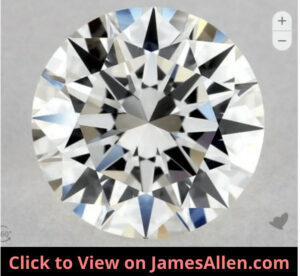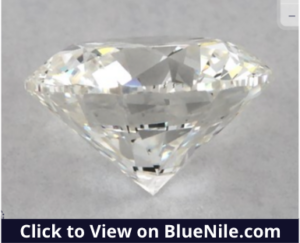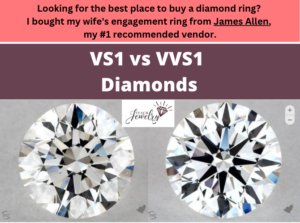
Diamonds with a clarity grade of VS1 (very slightly included) and VVS1 (very, very slightly included) both possess imperfections on their facets, yet the degree to which they affect the appearance is markedly different.
The main difference between a VS1 and VVS1 clarity diamond is that a VS1 diamond’s inclusions are more impactful on its brilliance, durability, and appearance. While the two may look identical without magnification, a VVS1 diamond has blemishes that are less apparent.
Let’s compare VS1 versus VVS1 diamonds, including:
- What to know about each
- Four differences
- Similarities
- Tips for deciding which is right for you
Here are the details.
What is a VS1 Diamond?
A VS1 clarity diamond has inclusions barely visible under 10x magnification.
To illustrate, check out the high-resolution image of this one-carat round cut that earned a VS1 clarity grade from James Allen, where I bought my wife’s engagement ring.
Even when the image is magnified, it’s difficult to identify flaws.
If you scan a VS1 diamond with a jewelers loupe, you won’t immediately notice the flaws.
But after a few scans back and forth, small pinpoints, a white twinning wisp, and a transparent feather along the edge may emerge.
But a VS1 clarity grade isn’t referring to the presence of a specific inclusion.
There could be one type that has several occurrences, or four or five different types of inclusions with one instance each.
For example, this 0.90-carat round cut diamond earned a VS1 grade.
Check out the GIA report that’s linked to on the site.
It notes a single knot and crystal.
Conversely, a diamond could receive the same clarity grade but have the following inclusions:
- Crystal
- Feather
- Needle
- Pinpoint
The gemologist determined that even though the first diamond had a higher number of inclusions, they affected each diamond in a similar way in terms of appearance and performance.
On the GIA and IGI scales, VS1 sits between VVS2 and VS2.
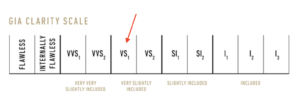
On the lower end of the scale at VS2, there are more inclusions present, and on the higher end at VVS2, they’re less impactful.
What is a VVS1 Diamond?
A VVS1 diamond has inclusions that are difficult to see at 10x magnification. Even a trained gemologist will scan a diamond multiple times to find hints of flaws.
When these inclusions are spotted, they generally have no impact on its aesthetic or performance. It could be a single pinpoint near the girdle or a few small feathers scattered across the table.
As an example, this 1.00-carat round cut diamond earned a VVS1 grade.
The GIA report notes only a pinpoint and feather.
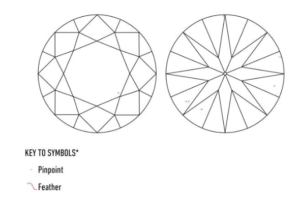
They’re even difficult to identify on the plot because they’re so small.
Others have pinpoints, naturals, and indented naturals.
Even though there are different numbers of imperfections in diamonds, gemologists can determined they have an equal impact.
On the GIA scale, it sits below internally flawless (IF).
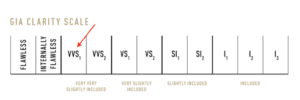
An IF diamond has no inclusions visible at 10x magnification.
It’s one grade above VVS2. Even though VVS2 diamonds have a more extensive presence of inclusions compared to VVS1, if you placed them next to each other, the naked eye couldn’t tell them apart.
Here’s an example of VVS2, VVS1, and internally flawless diamonds placed next to each other.
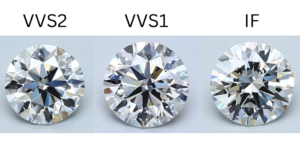
Even in high resolution images, they appear the same. There are no apparent inclusions.
Those who grade the diamonds would have to study them closely to discover the differences.
What are the Differences Between VS1 and VVS1 Diamonds?
1. VS1 Diamonds Often Have More Inclusions
VS1 diamonds often have a higher number of inclusions compared to ones with a VVS1 grade. This refers to both the total number of flaws and the various types.
For example, the below VS1 diamond has the following inclusions:
- Crystal
- Pinpoint
- Indented natural
- Natural
As a comparison, a VVS1 diamond may only have a twinning wisp and an etch channel.
But the number of inclusions isn’t the only factor taken into account. It also isn’t referring to an exact number.
You may find exceptions where a VS1 diamond has a singular, impactful inclusion, and a VVS1 diamond has multiple clarity characteristics.
2. VVS1 Inclusions Have Less Impact
Even if VVS1 and VS1 clarity diamonds have the same number and type of inclusions, VVS1 inclusions have less impact on durability, brilliance, and appearance.
In terms of durability, inclusions have the potential to cause a diamond to chip. Feathers are a top offender because they represent a fracture in the diamond’s structure.
Blemishes indicate a weaker point in the diamond, especially if it’s near an area that’s already fragile, such as an extremely thin girdle.
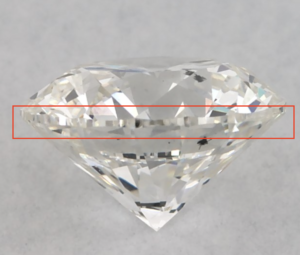
If it’s dropped or hit in this area, it’s more likely to break. It’s why buyers often cover these vulnerable areas with a setting like a bezel style.
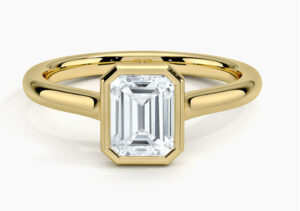
You shouldn’t be too concerned about the durability of a VS1 diamond, but the inclusions do weaken the diamond more compared to a VVS1 diamond.
Inclusions also diminish a diamond’s brilliance because they prevent light from properly entering and exiting facets.
When light hits an inclusion, it has the potential to distort the way it travels through the diamond.
That light won’t return to the viewer in the same way as when it travels freely.
A feather in a VS1 diamond may lessen its brilliance, but the quality that most impacts this trait isn’t clarity. Instead, brilliance is most affected by its cut.
If you’re focused on brilliance, don’t pay too much attention to VS1 versus VVS1 diamond clarity. Find a diamond with an excellent cut that’s also eye-clean.
Inclusions also affect the appearance of a diamond because they’re sometimes visible to the naked eye. In fact, when it comes to clarity, its effect on appearance is paramount.
You may notice internal graining, a dark crystal, or a cloud that makes the diamond look hazy.
For VS1 and VVS1 clarity diamonds, this isn’t an issue because the inclusions are often too small to see with the naked eye.
For example, I chose a VS1 diamond for my wife’s engagement ring. It’s eye-clean, and anyone who sees it would suspect it’s flawless.
I explored diamonds up and down the clarity scale and felt VS1 struck the right balance between affordability and quality.
3. VVS1 Diamonds Sell for a Higher Price
All else being equal, you’ll pay more for a VVS1 diamond compared to a VS1 diamond because its inclusions have less of an impact.
The price of a diamond increases with each grade up the clarity scale.
That’s true of other qualities such as color, carat weight, and cut.
So an SI1 diamond is less expensive than VS1, and VS1 costs less than IF.
The best way to understand how VVS1 diamonds are more expensive than VS1 clarity is to compare ones that have the same qualities in all other areas.
I compared diamonds from James Allen with the following qualities:
- Carat weight: 1.00
- Cut: Very good
- Color: F
For ones that earned a VS1 clarity grade, the average price is $5,258, with a range of $4,430-$5,960.
For ones with a VVS1 grade, the average price is $6,874. The lowest price is $5,270, and the highest is $8,410.
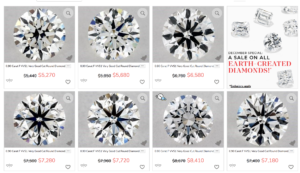
That’s a 31 percent increase in price for VVS1 versus VS1.
You can expect the price of a diamond to increase 10 to 20 percent for every step up the clarity scale. The jump is on the higher end when you move from one category to another, like from VS to VVS.
Another reason the price jumps is because diamonds with high clarity grades are rare. In fact, VVS1 represents less than one percent of all diamonds on the market.
So you can save on price by moving down the clarity scale.
You can put the savings a VS1 diamond offers toward a setting or higher carat weight, or you could improve its cut or color.
4. VS1 Diamonds are More Popular for Engagement Rings
If you’re shopping for an engagement ring, know that most buyers opt for a VS1 clarity diamond over VVS1.
In fact, VS1 is often considered the most common clarity. The reason is because buyers find it’s the right balance between a lack of inclusions and a low price.
Specifically, the advice is often to choose the lowest clarity grade required for it to still appear eye-clean.
While in many cases, there are one carat diamonds in that category that earn VS2 or SI1 grades, my interpretation is that buyers want a little extra margin to ensure there aren’t visible flaws on their engagement ring diamond.
I say that because it was how I landed on a VS1 diamond for my wife’s ring.
I knew I could continue the search at lower clarity grades, but it had all the other qualities I desired.
Combined with significant savings compared to VVS1, myself and many others avoid that end of the clarity spectrum and instead choose to spend on an excellent cut.
To illustrate, take a look at this engagement ring with a VS1 diamond.
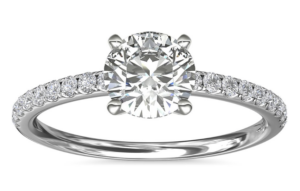
The diamond is clean and fit to stand at the center of the piece.
How to Decide Between VS1 and VVS1 Clarity Diamonds
Comparing VS1 versus VVS1 diamonds involves understanding how inclusions affect its overall appeal.
Here are some guidelines to help decide.
Choose a VS1 diamond if:
- You want a diamond that’s eye-clean, but you’re willing to pay a premium compared to others that don’t have visible inclusions, like SI1 or VS2
- The diamond is more than 1.5 carats, and you want to ensure inclusions aren’t visible
- You plan to protect its potentially weak areas with a quality setting
Consider a VVS1 diamond if:
- It’s important to you that it has very few inclusions
- You’re willing to pay a higher price compared to other eye-clean diamonds, even if they look the same without magnification
- You’re choosing a diamond larger than two carats and don’t want any visible inclusions
Explore a variety of diamonds at in-person and online retailers.
By pairing VVS1 and VS1 diamonds with a number of settings, you’ll land on the right combination for your ring.

Jacob Clarke
Jacob Clarke is the founder of TeachJewelry.com.
He earned an Applied Jewelry Professional Diploma from the Gemological Institute of America (GIA) and now brings you essential information about diamonds, settings, and more.
Jacob has consulted with leading jewelry brands, and his work has been cited in Clean Origin, Diamond Nexus and industry publications.
He's also a member of the International Gem Society.
He enjoys discussing jewelry with readers, so contact him with any questions at jacob.clarke@teachjewelry.com.

